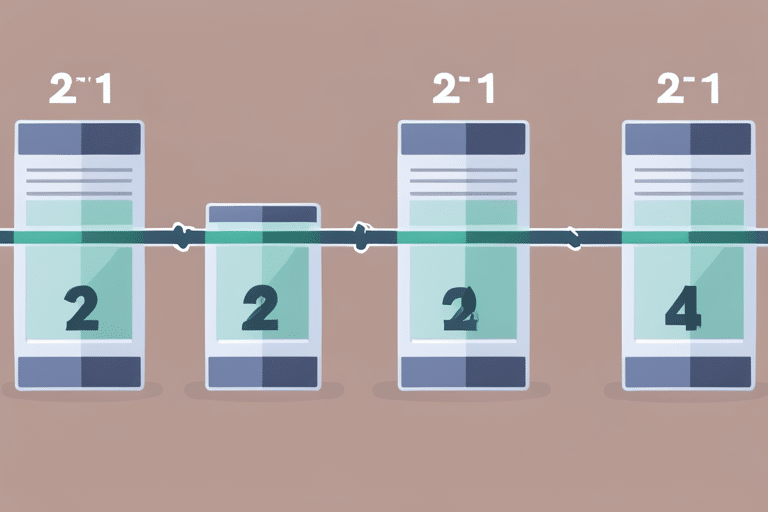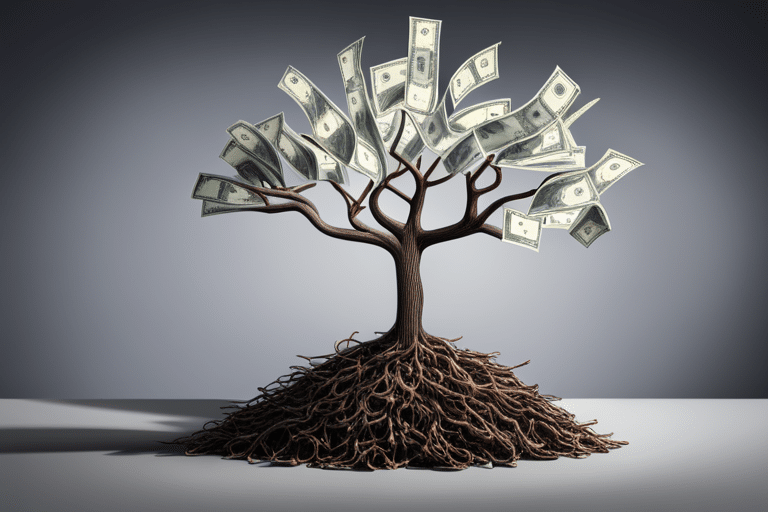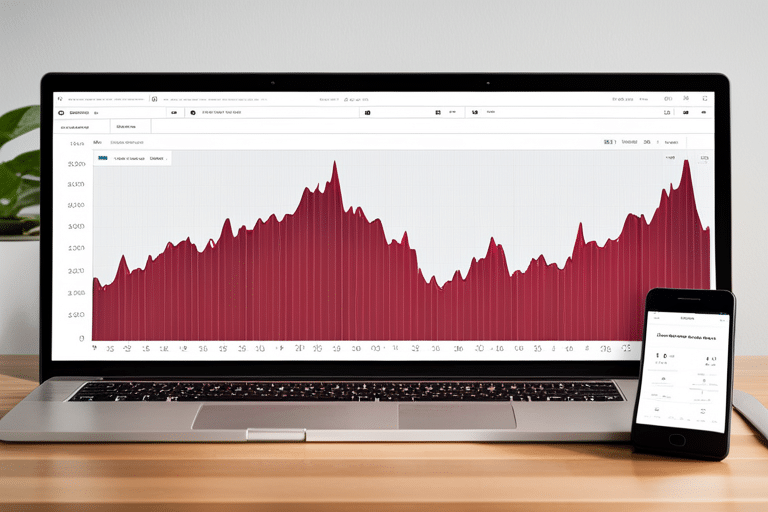Do you want to know a fascinating fact?
Well, did you know that stock splits are more than just numbers and decimal points? They have the power to shake up the market and impact investors like you in ways you might not expect.
So, if you’re ready for a journey into the world of stock splits, buckle up and get ready to uncover what they are and how they can make or break your investments.
Let’s dive in!
Key Takeaways
- Stock splits make shares more affordable for investors.
- Stock splits benefit small investors by increasing their ownership stake.
- Stock splits can attract more buyers and increase market liquidity.
- Stock splits are often viewed as a signal of potential growth and increased market demand.
The Basics of Stock Splits

Stock splits are a common event in the stock market. Don’t worry, it’s not like they take tiny hammers and break stocks into little pieces like a piñata at a birthday party. No, no! A stock split is when a company decides to divide its existing shares into multiple new ones. It’s like taking one big pizza and cutting it into smaller slices, so everyone gets more to eat.
Now, you might be wondering how understanding stock splits can impact your investor portfolio. Well, let me enlighten you! When a company announces a stock split, it often means that the share price has been soaring high up in the sky like a majestic eagle on steroids. The company wants to make its shares more affordable for investors because not everyone can afford those fancy-schmancy expensive stocks.
So what happens when there’s a stock split? Let’s say you own 10 shares of Company X at $100 per share (look at you, Mr./Ms. Moneybags!). If the company decides to do a 2-for-1 stock split, congratulations! You now have 20 shares of Company X at $50 per share. It’s like getting twice as many presents on your birthday without having to invite any extra people over.
But hold your horses! Before you go planning that trip around the world with your newfound wealth (or maybe just treating yourself to some extra guacamole), let’s dive deeper into understanding the purpose of these sneaky little stock splits and how they can affect both companies and investors alike…
Understanding the Purpose of Stock Splits

Are you a small investor looking to make big gains? Well, you’re in luck because stock splits offer some sweet benefits for you!
Not only do they make the price of individual shares more affordable, but they also increase market liquidity by attracting a larger pool of potential buyers.
And let’s not forget about the impact on stock price – it can skyrocket after a split, giving you even more reason to celebrate!
Benefits for Small Investors
Small investors, listen up! Stock splits are your ticket to increasing your holdings without breaking the bank. You don’t need to invest more money; you just need a little stock split magic!
But what exactly are the benefits for you? Well, let me break it down for you in a handy-dandy table:
| Benefit | Description | Advantage |
|---|---|---|
| More Shares | Stock splits increase the number of shares you own. | You get a bigger slice of the pie without spending extra dough! |
| Lower Price Per Share | After a split, each share is worth less, making it more affordable for small investors. | It’s like getting a discount at your favorite store – who doesn’t love that? |
| Liquidity Boost | Stock splits often lead to increased trading volume and liquidity, making it easier for you to buy and sell shares. | Say goodbye to those pesky market order delays! |
Increased Market Liquidity
After a split, the increased market liquidity provides you, the small investor, with more opportunities to buy and sell shares. It’s like being at a party where everyone suddenly starts doing the Macarena – things are getting wild!
With all this increased trading activity, there’s a frenzy in the air as investors scramble to get their hands on those freshly split shares. And let me tell you, my friend, this is good news for you. Why?
Well, when there’s more buying and selling going on, it means bid ask spreads start to narrow. That means you can get in and out of trades more easily without losing too much money on those pesky spreads.
Impact on Stock Price
When there’s increased market liquidity after a split, it’s like adding fuel to the fire of stock price movements. It’s like throwing a party for stock traders and telling them to bring their dancing shoes because things are about to get wild on the dance floor. You see, when a company decides to split its shares, it often results in more trading activity and investor excitement. This increased trading volume can have a significant impact on the stock price, causing it to move up or down rapidly.
To give you an idea of how this works, here’s a handy table that shows the potential impact of increased market liquidity after a stock split:
| Impact on Trading | Investor Sentiment |
|---|---|
| Increased volume | Positive |
| Higher volatility | Excited |
| Faster price moves | Energized |
| More opportunities | Optimistic |
| Increased risk | Thrilled |
As you can see, all this extra liquidity can make trading more exciting than a rollercoaster ride. So buckle up and enjoy the adrenaline rush!
Types of Stock Splits

Hey there, stock market enthusiast! Buckle up because we’re about to dive into the world of stock splits.
Today, we’ll be exploring two fascinating types: reverse stock splits and forward stock splits.
And guess what? These bad boys have a sneaky way of impacting those oh-so-important stock prices.
Reverse Stock Splits
To better understand reverse stock splits, you should know that they can result in a decrease in the number of shares you own.
Picture this: you’re at a party and everyone is sharing a delicious pizza. Suddenly, the host announces a reverse pizza split! Instead of getting more slices, each slice becomes bigger. So, if you had two slices before the split, now you only have one big slice after it.
That’s similar to what happens with reverse stock splits – the company reduces the number of shares by combining them into larger ones. Unfortunately, this means there will be fewer shares for investors like yourself.
It’s like going from owning multiple tiny pizzas to having just one gigantic slice. So be prepared for some shareholder dilution and remember to adjust your expectations accordingly!
Forward Stock Splits
Forward stock splits can result in an increase in the number of shares you own. So, let’s say you own 10 shares of a company that decides to do a forward stock split. Suddenly, boom! You now have 20 shares! It’s like magic, but with stocks instead of rabbits.
But wait, there’s more! Here are five reasons why forward stock splits can be pretty darn cool:
- Your ownership stake grows without spending any extra money!
- The price per share usually decreases after a split, making it more affordable for new investors.
- Increased liquidity means it’s easier to buy and sell those extra shares.
- Companies often choose to do forward splits when they want their stock to look more attractive to potential investors.
- Your overall shareholder equity remains the same even though you have more shares.
Now that you know how forward stock splits impact your equity as a shareholder, let’s delve into how they affect stock prices. It’s going to be mind-blowing!
Impact on Stock Prices
After a forward stock split, the price per share generally decreases, making it more affordable for new people looking to invest. This can have a significant impact on market dynamics and investor sentiment. Picture this: you’re at a fancy restaurant, craving steak but all you have is pocket change. Suddenly, the waiter comes over and says they’ve just slashed the prices in half! Now you can satisfy your carnivorous cravings without breaking the bank. That’s exactly how investors feel after a forward stock split – like they’ve been handed a golden opportunity on a silver platter. To illustrate this point even further, let’s take a look at our emotionally evocative table:
| Before Stock Split | After Stock Split | Emotional Response |
|---|---|---|
| High Prices | Lower Prices | Joyful |
| Limited Access | Increased Access | Excited |
| Exclusive Club | Inclusive Club | Thrilled |
| Elite Investment | Affordable | Ecstatic |
| Daunting | Approachable | Elated |
Exploring the Impact of Stock Splits on Share Price

The impact of stock splits on share price can be significant for investors. You might think a stock split is like sharing your pizza with a friend, where each slice becomes smaller but you still have the same amount of pizza. Well, in the world of stocks, it’s kind of like that but without the delicious cheese and tomato sauce.
So, here are five things you should know about how stock splits can affect share prices:
-
Increased liquidity: When a company announces a stock split, it signals to investors that the company is confident about its future prospects. This boost in investor sentiment usually leads to an increase in demand for the stock, resulting in higher liquidity and potentially driving up the share price.
-
Lower individual share price: One of the immediate effects of a stock split is that it reduces the price per share. Imagine having one cookie and splitting it into two equal halves. Each half represents one share after the split. The lower individual share price may attract more retail investors who previously found the high price intimidating.
-
Psychological impact: Stock splits can also have a psychological impact on investors’ perception of value. Seeing their number of shares increase after a split may make them feel wealthier and more optimistic about their investment.
-
Impact on stock returns: While there’s no guarantee that a stock split will result in higher returns, historically many companies experience positive short-term returns following a split due to increased trading activity and investor excitement.
-
No change in market capitalization: It’s important to note that even though the number of shares increases after a stock split, there is no change in market capitalization (the total value of all outstanding shares). Think of it as cutting your pizza into smaller slices – you still have the same amount overall.
How Stock Splits Affect Market Capitalization

So, you’ve learned all about how stock splits can affect the share price of a company. But did you know that they also have an impact on market capitalization? Oh yes, my friend, it’s time to dive into this exciting topic!
Market capitalization is a fancy term that refers to the total value of a company’s outstanding shares in the stock market. It’s calculated by multiplying the current share price by the number of shares outstanding.
Now, when a company decides to split its stock, it increases the number of shares available in the market without changing its overall value.
Let me break it down for you with an example. Imagine there’s a company called Banana Inc., and each share is currently worth $100. If Banana Inc. decides to do a 2-for-1 stock split, every shareholder will receive two shares for every one they own. This means that if you had 10 shares before the split, you’ll now have 20.
Now here’s where things get interesting – even though your individual stake in Banana Inc. has doubled, the overall value of the company remains unchanged. So while your personal wealth may not change overnight due to a stock split, investor sentiment often gets a boost because more affordable shares attract new investors.
The Effect of Stock Splits on Dividends

When a company decides to do a stock split, it doesn’t change the amount of dividends paid out to shareholders. So don’t worry, your love for dividends won’t be shattered like a broken piggy bank.
Let’s dive into the magical world of stock splits and see what impact they have on your precious dividend payouts.
Here are five things you need to know about how stock splits affect dividends:
-
Dividend per share remains unchanged: Just because a company decides to split its stocks doesn’t mean it will suddenly start skimping on your beloved dividend payments. The amount you receive per share remains the same.
-
Increased number of shares means smaller dividend payout per share: While the total amount of dividends paid out by the company stays constant, each individual share receives a smaller slice of the pie after a stock split. It’s like having one pizza cut into more slices – you still get the same amount of pizza, just in smaller pieces.
-
Dividend yield may decrease: With more shares floating around after a stock split, the dividend yield (dividends divided by stock price) may actually decrease. So if you’re all about that juicy yield, keep an eye on this little sneaky change.
-
Total dividend payment might increase: Although your individual dividend payout per share decreases after a stock split, fear not! The total amount paid out in dividends could actually increase since there are now more shares in circulation.
-
Company’s financial health is key: Remember that whether or not you receive any dividends at all depends on the company’s financial situation and its decision to distribute profits as cash rewards to shareholders. A stock split won’t magically create money out of thin air.
Stock Splits and the Perception of Value

Investors may perceive stock splits as a signal of potential growth and increased market demand. And who can blame them? It’s like getting a pizza and having it magically split into more slices without any extra charge. Who wouldn’t want that?
But let’s dive deeper into the perceived benefits of stock splits and how they play with investor psychology.
First off, let’s talk about the perception of value. When a company announces a stock split, it’s like they’re saying, ‘Hey, we’re doing well, and we want to make our shares more affordable for everyone.’ It’s like when your favorite ice cream shop has a buy-one-get-one-free deal – you just can’t resist grabbing that extra scoop! Similarly, investors see stock splits as an opportunity to buy more shares at a lower price per share. It feels like you’re getting more bang for your buck, right?
But there’s also something else going on behind the scenes – investor psychology. You see, when companies announce stock splits, it sends a message to the market that they have confidence in their future growth prospects. It’s like telling everyone at the party that you’ve got some killer dance moves – people start paying attention! So naturally, investors get excited too. They think, ‘If this company believes in itself enough to split its stocks, then maybe I should believe in it too.’
Analyzing the Impact of Stock Splits on Liquidity

Analyzing the impact of stock splits on liquidity can give us valuable insights into the market dynamics and trading activity surrounding these events. So, let’s dive in, shall we? Here are some interesting tidbits for you to chew on:
-
Increased Trading Volume: When a stock splits, it tends to attract more attention from investors who see it as an opportunity. This increased interest leads to higher trading volume, making the market more liquid than your favorite sports drink.
-
Improved Market Efficiency: Liquidity is like oil for the market’s gears. With more buyers and sellers participating due to a stock split, prices adjust faster and information spreads quicker. It’s like having a turbocharged engine in your portfolio!
-
Enhanced Investor Confidence: A stock split often signals that a company is doing well and its shares are in demand. This positive news can boost investor sentiment and make them feel all warm and fuzzy inside. Who doesn’t love feeling warm and fuzzy?
-
Potential Manipulation Opportunities: While most investors have good intentions, there are always a few rotten apples in every bunch. Some unscrupulous individuals may try to manipulate the market during a stock split by spreading false rumors or engaging in other shady tactics. But fear not! The regulators are here to save the day.
-
Temporary Price Volatility: Stock splits can lead to short-term price volatility as traders jockey for position. It’s like watching synchronized swimming with sharks – exciting but potentially risky if you don’t know what you’re doing.
Stock Splits and Trading Volume

Increased trading volume during stock splits can provide valuable insights into market dynamics and investor behavior. You see, when a company decides to split its stock, it’s like throwing a party in the stock market. Everyone gets excited and wants to get in on the action. It’s like trying to grab that last slice of pizza at a crowded party – everyone wants a piece!
During a stock split, the number of shares outstanding increases, but the overall value remains the same. This means that each share becomes more affordable for investors. And when something becomes more affordable, people tend to buy more of it. It’s like going to a clearance sale and finding out that your favorite designer shoes are suddenly half off – you just can’t resist!
But why does increased trading volume matter? Well, my friend, it gives us clues about how investors perceive the stock split and what their strategies might be. Are they buying because they think the price will go up? Or are they selling because they believe it’s reached its peak? The answers lie in those high trading volumes.
Let me break it down for you with this handy-dandy table:
| Trading Volume | Interpretation |
|---|---|
| High | Bullish |
| Low | Bearish |
| Average | Neutral |
So if you see high trading volumes during a stock split, it could indicate bullish sentiment – investors believe the price will rise. On the other hand, low trading volumes might suggest bearish sentiment – investors think the price has peaked and want to sell before it drops.
Now remember, my friend, this is just one piece of the puzzle. Other factors like market volatility also come into play when analyzing trading volume during stock splits. But armed with these insights, you’ll be well on your way to mastering the art of understanding investor behavior!
The Psychological Impact of Stock Splits on Investors

So, you’ve just heard that a company you invested in is doing a stock split. Exciting stuff!
Now, it’s time to dive into the fascinating world of investor psychology after splits. Get ready for some emotional rollercoasters, as investors go from feeling like financial gurus to questioning their every move.
But hey, don’t worry – we’ll also explore how these splits can create the illusion of increased value and have everyone seeing dollar signs.
Let’s jump right in!
Investor Mindset After Splits
Don’t worry, your mindset as an investor can shift after stock splits occur. It’s like wearing a new pair of glasses that magically make everything seem brighter and more exciting. Suddenly, you’re filled with optimism and ready to conquer the market.
So, what are some strategies you can adopt to make the most out of this post-split euphoria? Let me enlighten you:
-
Embrace the opportunity: See stock splits as a chance to buy more shares at a lower price.
-
Stay informed: Keep up with company news and updates to gauge future performance.
-
Diversify wisely: Spread your investments across different sectors for stability.
-
Set realistic goals: Define clear objectives and timelines for your investment journey.
-
Trust yourself: Have confidence in your decisions and don’t let short-term fluctuations shake you.
With these strategies in mind, you’ll navigate the post-split world like a true master investor.
Happy investing!
Emotional Response to Splits
Remember to acknowledge and embrace your emotional response when it comes to navigating the world of stock splits. Yes, my friend, investing can be a rollercoaster ride of emotions.
One minute you’re riding high on the news of a split, and the next you’re questioning your life choices as the market takes a nosedive. But fear not! It’s all part of the investor mindset.
Embrace those butterflies in your stomach and let them remind you that you are human, after all. Take a deep breath and remember that emotions are normal, but don’t let them cloud your judgement.
Stay focused on your long-term goals, do your research, and ride out those emotional waves like a pro surfer riding a tsunami (okay, maybe not that extreme).
Keep calm and invest on!
Perception of Increased Value
Investing in a company that has undergone a split can create the illusion of increased value. It’s like getting two donuts instead of one, even though they’re smaller. But hey, more donuts is always a good thing, right? Well, not exactly.
Here are some things to consider when it comes to the perception of increased value:
-
Double the shares, same pie: A stock split doesn’t change the overall value of your investment. It just slices it into smaller pieces.
-
Psychological boost: Seeing more shares in your portfolio can make you feel like you’ve struck gold. But remember, it’s all about perception.
-
Market dynamics at play: Increased stock price may attract new investors who think they’re getting a bargain. This demand can drive up prices temporarily.
-
Short-term gains vs long-term growth: Don’t let the illusion of increased value cloud your judgment. Focus on the company’s fundamentals for sustainable growth.
-
Keep an eye on liquidity: Stock splits can increase trading activity and liquidity in the market, which could be advantageous for investors.
Historical Analysis of Successful Stock Splits

If you’re curious about the impact of historical successful stock splits, let’s dive into the analysis. Now, before we get all serious and analytical, let me paint you a picture. Imagine you have a pizza. A delicious, cheesy pizza. But this pizza is too big for just one person to handle. So what do you do? You slice it up into smaller pieces! Voila! The same concept applies to stocks when they undergo a split.
Now, let’s take a look at some historical performance data of successful stock splits to see if they really make a difference in investor behavior. Below is a nifty table that showcases four companies and their respective stock prices before and after the split:
| Company | Stock Price Before Split | Stock Price After Split |
|---|---|---|
| Apple | $200 | $100 |
| Amazon | $3000 | $1500 |
| $1500 | $750 | |
| Microsoft | $250 | $125 |
As you can see, after the split, the stock prices are halved while the number of shares doubles. It’s like getting two smaller slices instead of one big slice of pizza!
But does this actually impact investor behavior? Well, historically speaking, many investors perceive lower-priced stocks as being more affordable and accessible. They may feel like they’re getting a bargain deal on those post-split shares.
However, it’s important to note that while successful stock splits may create excitement and attract new investors in the short term, their long-term impact on overall performance is debatable.
The Role of Stock Splits in Market Performance

Now let’s explore how stock splits contribute to market performance.
Stock splits, my friend, are like a magic trick that can make investors feel like they’re getting more bang for their buck. Here’s a little journey into the world of stock splits and how they impact the market:
-
Increased liquidity: When a company decides to split its stock, it’s like adding a splash of water to your favorite drink – suddenly, it becomes more refreshing and easier to gulp down. Stock splits increase the number of shares available, making it easier for buyers and sellers to trade.
-
More accessibility: Picture this: you’re at an all-you-can-eat buffet with limited choices. Suddenly, they decide to add a whole new section just for desserts! That’s what happens when companies split their stocks – it opens up new opportunities for smaller investors who may have found the original price too high.
-
Market frenzy: Ahh, nothing gets Wall Street buzzing quite like a good ol’ stock split announcement. It’s like telling your friends you’ll be performing magic tricks at the next party – everyone wants in on the action! The excitement surrounding stock splits often leads to increased trading volume and volatility in the market.
-
Perception boost: Imagine walking into a room wearing an expensive suit versus one from your favorite discount store. People might judge you differently based on appearances alone! Well, my friend, stock splits can give companies that same boost in perception. A lower share price after a split might make investors perceive the company as more affordable or attractive.
-
Economic indicator: Just as birds migrating south signals winter is coming, stock splits can sometimes be seen as an indication of positive things ahead for both the company and the broader market. It’s like nature giving us a gentle nudge that better times could be on their way!
Implications of Stock Splits for Long-Term Investment Strategies

When considering long-term investment strategies, it’s important to take into account the implications of stock splits.
Now, I know what you’re thinking – ‘What on earth is a stock split and how does it impact my precious investment portfolio?’ Well, my friend, let me break it down for you in a way that even your grandma would understand.
Imagine you have a deliciously large pizza, and you want to share it with your friends. But wait! You only have one slice left. What do you do? You decide to cut that slice in half so everyone gets a fair share. Voila! That’s essentially what happens during a stock split.
A stock split occurs when a company decides to divide its existing shares into multiple ones. For example, if you own one share of XYZ Company and they announce a 2-for-1 stock split, congratulations! You now own two shares of XYZ Company.
But how does this impact your long-term investment strategy? Well, let me tell you. Stock splits don’t change the overall value of your investment but they do increase the number of shares you hold. This means that the price per share will decrease accordingly.
So why should you care about all this splitting business? Well, my savvy investor friend, here’s the deal: stock splits can create more liquidity in the market and attract more investors. Plus, they often signal confidence from the company’s management about its future prospects.
Frequently Asked Questions
How Do Stock Splits Affect a Company’s Financials and Profitability?
Stock splits can be a game-changer for companies. They don’t directly impact financials or profitability, but they do affect the stock price and your ownership percentage. So grab some popcorn and watch those numbers dance!
Are There Any Potential Risks or Disadvantages Associated With Stock Splits?
Potential risks and disadvantages of stock splits include increased market volatility, dilution of ownership for shareholders, and the possibility of a reduced stock price. But hey, don’t worry! Knowledge is power, so stay informed and master those risks!
Can Stock Splits Impact a Company’s Ability to Attract or Retain Investors?
Stock splits can definitely impact a company’s ability to attract or retain investors. When a stock price is reduced, it becomes more affordable and accessible, increasing market liquidity and potentially attracting more investors.
How Do Stock Splits Affect the Options Market and the Pricing of Options Contracts?
Hey, you curious investor! Let’s talk stock splits and their impact on the options market. Brace yourself for some mind-bending fun as we dive into how these splits can shake up options contract pricing!
Are There Any Regulations or Guidelines in Place Regarding Stock Splits That Investors Should Be Aware Of?
Before diving into the world of stock splits, it’s important to know that there are some regulatory requirements and investor considerations you should be aware of. Let’s explore these together!
Conclusion
Congratulations! You’ve made it to the end of this wild ride called ‘Stock Splits: What They Are and How They Impact Investors.’
Now that you’re armed with all this knowledge, you can confidently navigate the world of stocks like a pro. Remember, as they say, ‘Don’t put all your eggs in one basket!’ Just like how diversifying your investments is key to success, understanding stock splits is crucial for any investor.
So go forth and conquer the market with your newfound wisdom! Happy investing!

